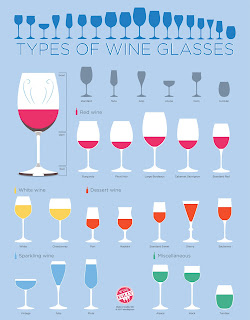Types of Glasses
Is it possible to have too many glasses? Maybe, maybe not. I became more educated on different styles of glasses as we worked our way through the beverage section of the Columbia Restaurant Cookbook, and I figured I should pass along that knowledge.
Most glasses can be categorized as tumblers or stemware. Stems were added as handles to prevent the temperature of your hand from affecting the temperature of your drink. The shape can make a difference as well, but since I have no desire to become a wine afficianado, I'm not going to bother figuring it out.* If you want to increase your knowledge further, this site was quite helpful.
*Here's a sample of what you could learn: "A white wine glass is small, designed to keep the wine cooler longer. White wines have a less intense aroma, and their glasses have smaller mouths and bowls because they don't need the extra surface area for the best flavor and aroma as red wines do."
Most glasses can be categorized as tumblers or stemware. Stems were added as handles to prevent the temperature of your hand from affecting the temperature of your drink. The shape can make a difference as well, but since I have no desire to become a wine afficianado, I'm not going to bother figuring it out.* If you want to increase your knowledge further, this site was quite helpful.
During our multi-month experiment, we used (or will use) the following glasses:
large wine glass
tall tulip glass
martini glass
champagne flute
collins glass
highball glass
old-fashioned glass
I didn't have to buy the last two; apparently we've been using highball glasses as water glasses and an old-fashioned glass for our morning milk as long as I can remember. I also learned that our crystal goblets (used for water for Sunday dinner in the dining room) are, indeed, water goblets and not wine glasses. (See here.) Wine glasses are thin and smooth and water goblets can be thick and etched. Did you know that? I was thinking I could use them instead of buying a tall tulip glass, but apparently not!
*Here's a sample of what you could learn: "A white wine glass is small, designed to keep the wine cooler longer. White wines have a less intense aroma, and their glasses have smaller mouths and bowls because they don't need the extra surface area for the best flavor and aroma as red wines do."

Comments
Post a Comment